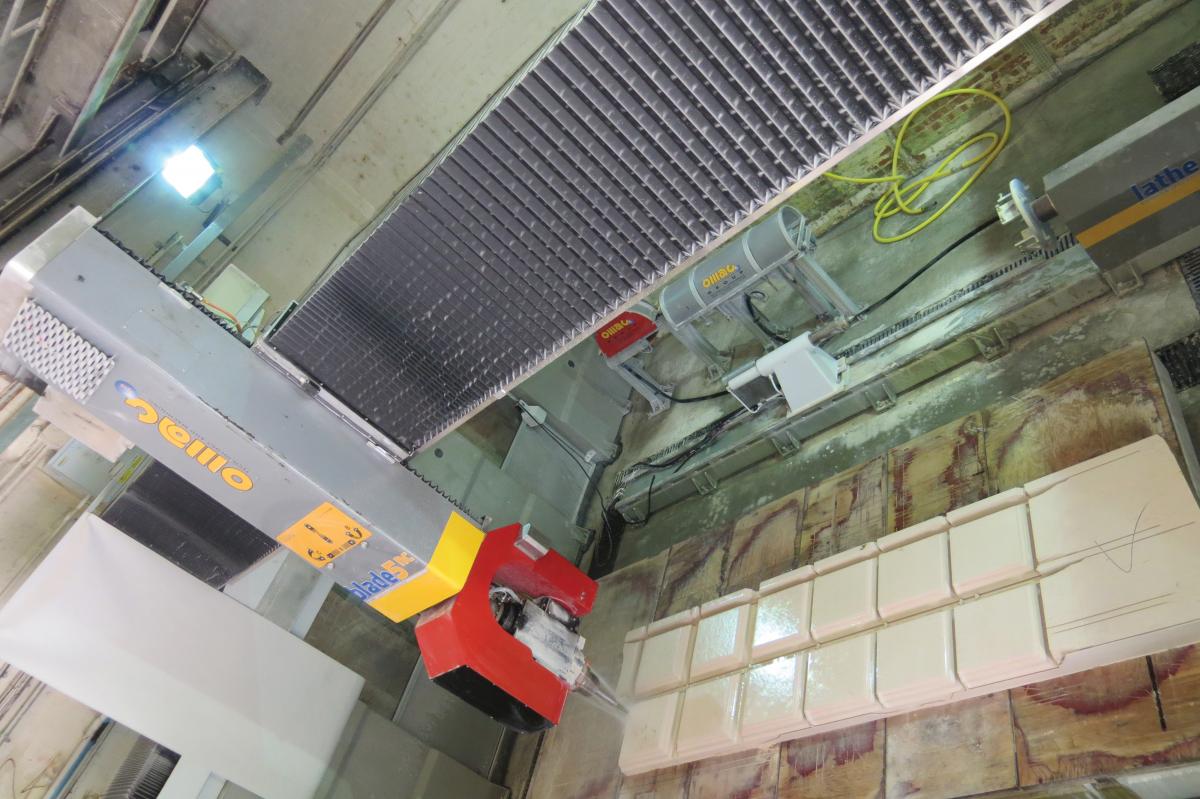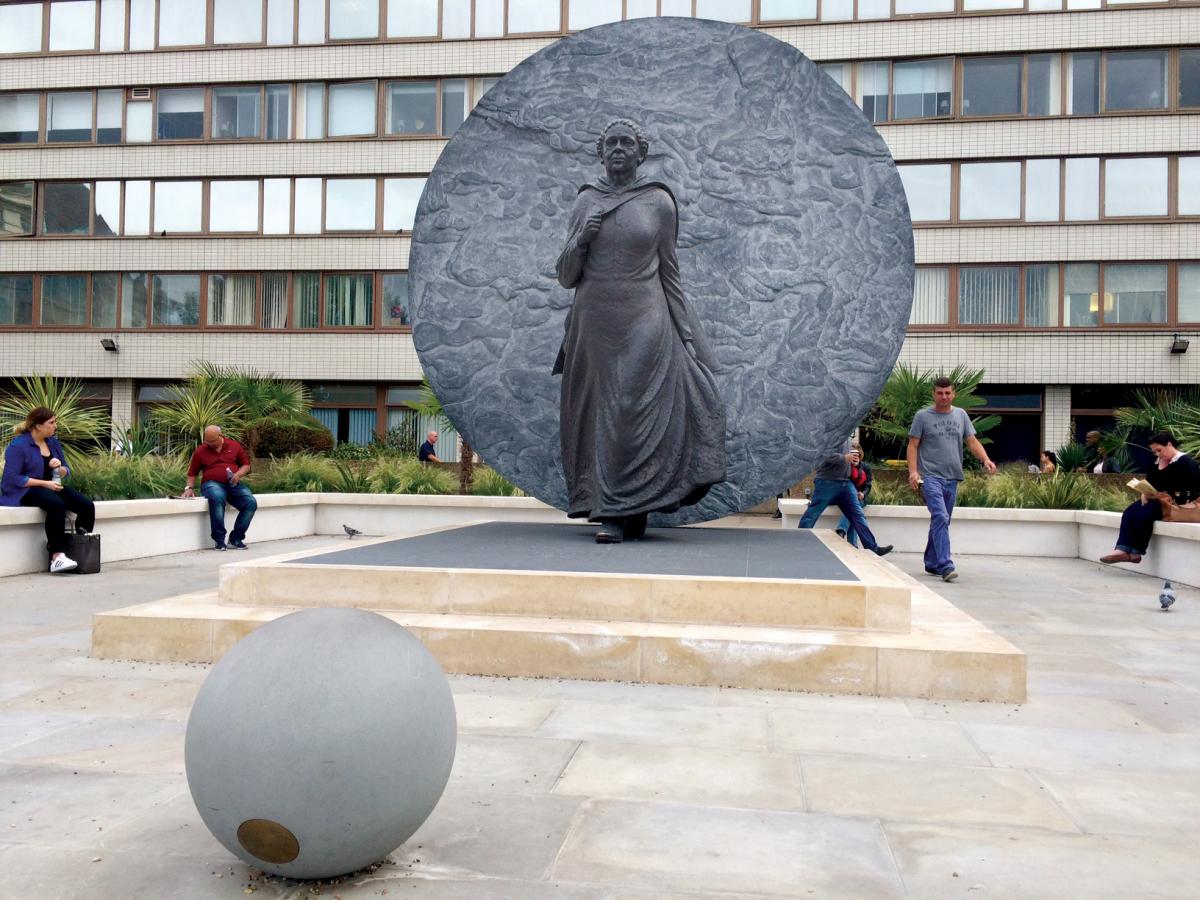Chichester Stoneworks: ‘We are at the beginning of a journey to build something really special here’
Investment in computer controlled machinery and hand skills training both have their place as Chichester Stoneworks evolves.
When Chichester Stoneworks invited its customers to an open day at its workshops and offices in the autumn to see its latest investments in computer technology, Managing Director Adam Stone said: “ We are at the beginning of a journey to build something really special here.”
 Last year Adam, who had once maintained that a mason could outperform computer-controlled machinery, invested in a five-axes Omag with a lathe attachment, bought from UK Omag agent D Zambelis, and a 3D laser scanner. He proudly showed them off during the open day, scanning the faces of visitors and running a raffle, the winner awarded a bust of themselves carved in stone by the Omag.
Last year Adam, who had once maintained that a mason could outperform computer-controlled machinery, invested in a five-axes Omag with a lathe attachment, bought from UK Omag agent D Zambelis, and a 3D laser scanner. He proudly showed them off during the open day, scanning the faces of visitors and running a raffle, the winner awarded a bust of themselves carved in stone by the Omag.
Adam has not lost his admiration for masonry hand skills, but he learnt the hard way that computer-controlled machinery also has its place when he pitted masons against machines on the production of a coat of arms.
Computing power just keeps on getting faster and more capable and it can play a part in making the production of masonry and carvings quicker and more affordable, although Adam still believes hand skills have a vital role to play in stonework. But so does technology and now Adam has welcomed it into the workshops with the enthusiasm of a convert.
The first project off the Omag was a Forest of Dean Pennant sandstone light housing for the illumination of the Mary Seacole statue (pictured below) unveiled in the garden of St Thomas’ Hospital, London, directly opposite the Houses of Parliament, in June last year.
Mary Seacole worked alongside Florence Nightingale in the hospitals of the Crimean War. The statue, created by sculptor Martin Jennings, is the first in the UK dedicated to a named black woman. The statue and the disc behind it are bronze.
Since that first piece, the Omag has played its part in many of Chichester Stoneworks’ projects, although it was not the only investment last year. The company also replaced an old Van Voorden saw with a new 1200mm Wells Wellcut and its water recycling system with new ItalMecc plant that Steve Langton, the Works Manager, says is 120% more efficient than what it replaced.
But machines are only part of the project, says Adam. “Much more important is our team. We have an award-winning, industry-leading team and we maintain a robust training schedule to ensure we maintain and build on those skills.” The company employs 20 people, including 12 masons and four trainees in the workshops and offices.
When you ask Adam Stone what were Chichester Stoneworks’ highlights of 2016, he has to think. His focus is on what’s ahead, not what’s already finished. At first he struggles. “We didn’t build any huge mansions or monuments,” he says. Then he starts recalling what the company did do.
“We supplied £250,000-worth of Portland Perryfield mid tier cladding to Schneider UK for a new top storey and mansard roof of 48 Leicester Square.
“We carried out £500,000 worth of restoration and hard landscaping to Brighton College, working with flint, brick, terracotta and Stoke Ground Basebed Bath stone.
“We took on Chichester Stoneworks’ second Apprentice, Emma Sheridan. Will Lovell, our third year apprentice, was awarded first prize in the UK Skills competition, which was presented to him at the Stone awards on 2 December. Both Emma and Will won first prize for their year in the Worshipful Company of Masons’ Boss stone competition at Weymouth College and both of them also became Young Georgians with the Georgian Society for their part in the installation of a new fireplace in the Georgian Society building in Fitzroy Square.”
The fireplace for the Georgian Society, came about as a result of a new banker masonry shop created at the Weald & Downland Open Air Museum of buildings at Singleton, just outside Chichester, which Chichester Stoneworks built. This came about through the Masons Livery Company, of which Adam is a Liveryman. The Company supports trainees, who give demonstrations of stonemasonry at the Weald & Downland Museum.
Adam: “We were approached by Russell Taylor Architects to provide a new chimney piece for the entrance hall to the Georgian Society building in Fitzroy Square, in Fitzrovia, London.”
The stone, Portland Basebed, was donated by Albion Stone. Will and Emma, along with Alex Waddle of Winchester Cathedral, Joe Milne of Exeter Cathedral and Andrew Smith, who works in conservation and restoration in the West Country, all took part in working the stone in the open air at weekends through November and December at the Weald & Downland Museum, and then at Chichester Stoneworks’ banker shop when the weather turned bad. They were supported by Lee Saunders and Adam Stone and they installed the chimneypiece in one very hard day’s work on 14 January this year.
Chichester Stoneworks’ other two trainees are Chris Perress and Liam Creighton, who are studying for construction management degrees at Southampton Solent University.
Other major projects for Chichester Stoneworks in 2016 included adding to and rebuilding the new facade to the Ermenegildo Zegna menswear shop in New Bond Street, London, in Portland Perryfield limestone.
Using the Omag and the new £12,000 scanner that had been shown off during the company’s open day, 20 replacement lion heads were produced for Szerelmey Restoration for a project in Grosvenor Terrace. Chichester Stoneworks’ carvers Gordon Utting and Tom Francis hand finished each one.
The company carried out intricate and imperceptible structural repairs to the great bay window on the Lutyens House at Little Thakeham using Wealden Sandstone.
Staircases – especially superbly elegant cantilevered elliptical staircases that are de rigueur for the stylish mansion – have become a staple for Chichester Stoneworks and more were made and installed last year.
Intricate carving and restoration work was carried out for Ready Money Fountain in Hyde Park using Carrara marble. Once again, the 3D scanner and Omag supplemented years of experience, skill and talent, this time provided by Gordon and Leszek Polewczyk.
Working with Szerelmey Conservation, a company that shares Chichester Stoneworks’ offices, a new Tercentenary Chapel and Cloisters were installed for the Royal Artillery at Larkhill Camp in Wiltshire using Clipsham Stone from the Bullimores quarry and many thousands of bricks. Mervyn King, Szerelmey Conservation’s Contracts Manager, met The Queen when she laid the foundation stone in July. Mervin and Adam Stone, along with their partners, were at the formal dedication at the annual St Barbara’s service in December.
Chichester Stoneworks built a new Church Hall extension at the Church of St John the Evangelist, Redhill, using flint walling and Stoke Ground Basebed for six tracery windows, a colonnade and dressings, with an Armatherm thermal barrier between the interior and exterior stonework of the windows.
There was the restoration and waterproofing of Southampton’s Historic Bargate; the replica of an Art Deco facade on a new building for the University College of London Hospital in Portland Perryfield Mid Tier; the design and build (again in collaboration with Szerelmey Conservation) of two 48-berth mausoleums at Brookwood Cemetery in Surrey with Portland Perryfield Mid Tier and Black Zimbabwe Granite plaques.
Collapsed 13th Century vaulting in the Abbey at Swaffham Bulbeck in Cambridgeshire was rebuilt, mostly re-using the original clunch stone following the collapse but supplemented where necessary with stone first from Barrington Quarry and then, when that was no longer available, from Totternhoe Quarry. Adam describes that as an “interesting and challenging project”.
And to round off the year, recognition in the ‘Technical Innovation’ category of the Natural Stone Awards, presented in London in December, for the four Massangis limestone lions, each weighing 12tonnes, from the year before (featured in NSS October 2015).
They were produced in conjunction with the Stoneworld robot in Oxfordshire, using a mixture of 3D computer-aided design and manufacturing programs from Alphacam and the Eureka operating system of the robot, followed by 10 weeks of hand finishing by three of Chichester Stoneworks’ masons.
And now?
Adam: “Some of our people have moved on and others have joined. The team is developing and strengthening well. We look forward to a promising year ahead. Already new orders are coming in and tenders are piling up.”
